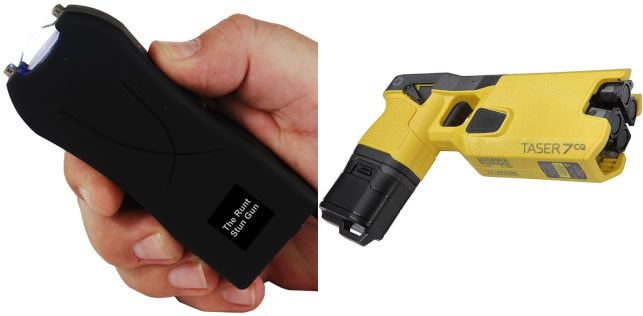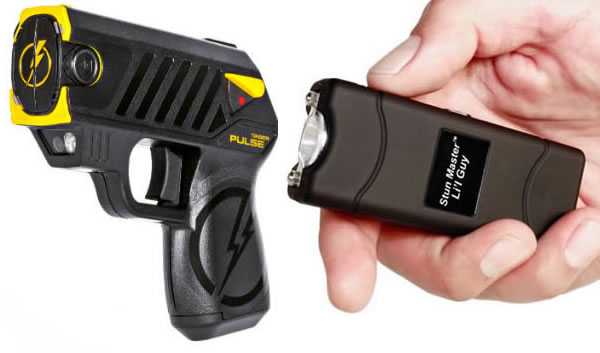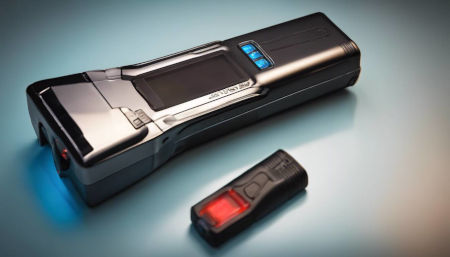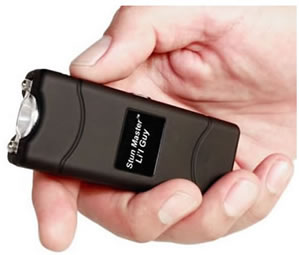Stun Gun vs Taser
Stun guns and tasers, though both designed for personal safety, work in different ways. A stun gun requires you to be close enough to touch your attacker, whereas a taser allows you to keep some distance. This suggests that tasers might offer more control during tense situations. However, remember everyone's situation is unique, and depending on your comfort level and context, a stun gun might be all that you need. Now, let's take a closer look at these tools.
While both stun guns and Tasers are effective self-defense tools, they operate differently. Stun guns require direct contact with the target, delivering an electric shock upon contact, whereas a Taser can be deployed from a distance using probes that attach to the target, providing a more extended reach for self-protection. Each has its advantages, so it's important to consider your specific safety requirements before making a choice.

Stun Guns vs Tasers: An Overview
Stun guns and tasers share the common goal of incapacitating attackers without causing lethal harm, yet their operational methods set them distinctly apart. A stun gun typically requires direct contact with the target to deliver an electric shock, while a taser can be utilized from a distance using probes shot towards the target.
The key difference lies in the mode of operation; a stun gun delivers a jolt only upon physical contact, whereas a taser provides the ability to incapacitate from a distance, offering an advantage in situations where proximity to the assailant may not be feasible or safe.
Stun Guns
Stun guns are handheld devices that deliver an electric shock upon contact with the body. The shock disrupts the muscle function of the target, causing a temporary loss of control and coordination, allowing for a safe escape. Known for their ease of use and portability, stun guns remain popular choices for reliable personal protection.
Stun Guns are a Direct Contact Weapon
Lil Guy 60,000,000 volts Stun Gun W/flashlight and Nylon Holster
The effectiveness of a stun gun stems from its ability to cause intense pain and muscle contractions, rendering the attacker temporarily incapacitated without inflicting serious injury.
Tasers
In contrast, tasers are equipped with probes that can be deployed from a distance using compressed air or gas, discharging electrical current upon striking the target. This effectively subdues the attacker by causing neuromuscular incapacitation. Tasers are designed to neutralize threats from a safer distance, providing valuable time to seek help or remove oneself from harm's way.
This remote incapacitation feature makes tasers particularly advantageous when dealing with potentially dangerous individuals who may be carrying weapons or when intervening in situations where physical engagement poses heightened risks.
It is important to carefully evaluate individual safety needs and consider factors such as physical capability, training, and potential encounter scenarios when determining which non-lethal self-defense tool best aligns with personal security objectives.
Understanding these fundamental differences between stun guns and tasers offers invaluable insights into their distinct advantages and operational mechanisms, helping individuals make well-informed choices tailored to their specific safety requirements.
Key Differences Between Stun Guns and Tasers
When it comes to self-defense tools, understanding the operational disparities between stun guns and tasers is paramount. Stun guns work by directly contacting the target, delivering a powerful shock upon contact. In contrast, tasers have the capability to deploy probes from a distance, transmitting the shock remotely. This distinction in operation significantly impacts their effectiveness and range.
Operation
While stun guns necessitate physical contact with the target to deliver an electric shock, tasers can be utilized from a distance using probes that transmit the shock. This means that with a taser, one can incapacitate an attacker from a safe distance, providing additional safety and preventing potential physical harm.
Additionally, this significant difference in operation also affects the user's ability to defend themselves in diverse situations. When an assailant is within close proximity, a stun gun may be more effective due to its direct contact nature. However, when faced with a threat from a greater distance, such as in a parking lot or in an outdoor setting, a taser's ability to immobilize from up to 15 feet away becomes invaluable.
Range
Distinguishing these self-defense tools includes considering their respective ranges. Stun guns have very limited range and typically require the attacker to be within arm's reach for effective use. Conversely, tasers have a significantly longer reach, capable of incapacitating from a distance of up to 15 feet. This substantial difference in range is a crucial factor in determining the appropriate choice for personal protection.
| Type | Range | Link |
|---|---|---|
| 1. Stun Guns | 0" - Direct contact must be made | Check Options |
| 2. TASER weapon | 15 Feet - Shoots probes from a distance | Check Options |

In practical terms, this means that carrying a stun gun might be beneficial when walking alone in poorly lit areas or enclosed spaces where an attacker could quickly close the distance. On the other hand, having a taser on hand would be advantageous in scenarios where potential threats are at a greater distance away.
Form Factor
The form factor of these self-defense devices plays a crucial role in their usability and deployment during high-stress situations. Stun guns are typically handheld devices resembling flashlights or small batons, making them easy to carry discreetly and access quickly when needed. Conversely, tasers are often pistol-shaped, utilizing a trigger mechanism to deploy wired probes toward the target. The design variances between stun guns and tasers contribute to how they are carried and accessed during confrontational encounters.
For individuals with mobility concerns or those who prefer less conspicuous options for personal protection, the compact size of a stun gun offers portability and ease of use. Alternatively, individuals who desire greater control in potentially threatening situations may appreciate the familiar handling of a taser due to its pistol-like design.
Understanding these fundamental differences between stun guns and tasers provides valuable insights into their functionality and applicability for personal safety. Each feature uniquely impacts their effectiveness in various self-defense scenarios.
Effectiveness of Stun Contact Weapons

Stun guns are designed to protect you in close quarters with an attacker. They are effective in close-range encounters, particularly when physical contact with the assailant is possible. The electric shock delivered by a stun gun prongs disrupts the body's neuromuscular system, leading to a temporary loss of muscle control. This results in disorientation for the attacker and provides an opportunity for you to escape from the threat.
The electrical discharge causes pain and can incapacitate your assailant for a brief period, giving you enough time to get away from the danger. Unlike projectile-based or long-range weapons, stun guns give you the advantage of being used at a very close distance without causing permanent harm to the attacker. While this effect is temporary, it can be crucial in creating a window for self-defense.
Let's imagine a scenario where an assailant gets too close for comfort. In such situations, using a stun gun can incapacitate them temporarily, allowing you to flee to safety. The disorientation caused by the electric shock hinders their ability to pursue or harm you, providing a valuable escape opportunity.
Furthermore, stun guns do not require pinpoint accuracy to be effective, making them suitable for high-pressure situations where precision aiming may not be possible. This ease of use under pressure is a significant advantage in real-life self-defense scenarios. This makes stun guns especially useful for individuals who may face potential threats in close-quarters environments such as parking lots, public transportation, or small enclosed spaces.
It's important to remember that while stun guns are effective in certain situations, they are not a panacea. It's always best to prioritize personal safety through awareness and preventive measures whenever possible. However, having a stun gun on hand can provide an added layer of protection and peace of mind in potentially dangerous situations.
The tactical advantages of stun guns in close-range encounters make them an important tool for self-defense in real-world scenarios. The ability to quickly and effectively neutralize threats at close proximity can be crucial in ensuring personal safety when faced with unexpected danger.
Effectiveness of Tasers
Tasers are designed to incapacitate a threat from a distance, providing an advantageous option when physical contact is unfeasible or risky. This makes them highly effective in scenarios where maintaining a safe distance from an assailant is crucial. The wired probes discharged by a Taser allow for incapacitation without the need for close-quarter combat, offering a vital advantage in situations where engaging at close range is undesirable or impossible.
One key aspect that sets Tasers apart from stun guns is their ability to reach out and neutralize a threat from a significant distance. This feature enables law enforcement personnel, security professionals, and individuals to subdue an assailant without direct physical confrontation, reducing the risk of injury to both parties involved.
Effective deployment of a Taser relies on the ability to target the assailant accurately and discharge the wired probes with precision. This precision ensures that the electric shock is delivered, achieving quick incapacitation and allowing for safe resolution of a potentially dangerous situation. In essence, Tasers provide a means of defense that minimizes the chances of physical harm while effectively neutralizing a threat.
The wired probes from a Taser can penetrate clothing to make direct contact with the target’s body. This enhances their effectiveness by ensuring that the electric shock is transmitted directly to the assailant, regardless of any protective layers they may be wearing. As a result, Tasers offer consistent and reliable means of incapacitating an attacker without the need for physical struggle or close-quarter combat.
The impact and effectiveness of Tasers have been widely recognized in law enforcement and security circles due to their capacity to swiftly de-escalate confrontations without escalating physical violence. Their ability to subdue assailants from a distance makes them invaluable tools for controlling and diffusing potentially volatile situations, ultimately contributing to overall public safety.
In summary, Tasers present distinctive advantages in situations where maintaining distance from an attacker is critical or when physical contact may not be possible or desirable. Their wired probes enable precise incapacitation without close combat, making them an effective tool for law enforcement as well as individuals seeking reliable self-defense options.
Now let's turn our attention to understanding how to safely handle stun guns in comparison with Tasers in various situations.
Safety Measures
Stun guns and tasers are effective tools for personal safety, but they should be handled with care and responsibility. Understanding the safety features and best practices for operating these devices is crucial to prevent accidents or unintended harm. Whether used for self-defense or stored at home, following safety guidelines ensures that they serve their intended purpose without causing harm.
One of the most critical safety measures is to keep stun guns and tasers out of reach of children. These devices are not toys, and their powerful electrical discharges can cause serious harm if mishandled. It's essential to store them securely in a location inaccessible to children and emphasize the importance of never handling these devices without proper knowledge and supervision.
In addition to keeping these devices away from children, it's essential to familiarize yourself with local regulations regarding their use and possession. Different areas may have specific laws governing the ownership and use of stun guns and tasers, so staying informed about legal restrictions can prevent potential legal entanglements.
It's crucial to understand that while stun guns and tasers are designed for self-defense, they are not foolproof. They should never be seen as a substitute for exercising caution, using de-escalation techniques, or seeking help from law enforcement when encountering a potentially dangerous situation. These devices are meant to provide an additional layer of protection in emergency situations but should be used judiciously and responsibly.
For instance, if you're carrying a taser for personal protection, consider investing in a holster that secures the device safely yet allows quick access when needed. This not only prevents accidental activation but also ensures that you can reach for it effectively in an emergency without fumbling or causing delays.
| Safety Measure | Description |
|---|---|
| Keep out of reach | Store devices securely and away from children to prevent accidental mishandling |
| Know local regulations | Stay informed about laws governing the use and possession of stun guns and tasers |
| Exercise caution | Use these devices responsibly alongside other safety practices in emergency situations |
| Secure storage | Invest in suitable holsters or secure storage options to prevent accidental activation |
By incorporating these safety measures into your routine, you can effectively harness the protective capabilities of stun guns and tasers while minimizing the risks associated with their use.
Understanding and practicing safe operation is vital when it comes to utilizing stunning devices as a means of defense. By following these essential safety measures, individuals can mitigate potential risks when handling stun guns and tasers.
Cost Analysis
When deciding between a stun gun and a taser, cost is often a major factor. Let's break down the cost considerations for both options to help you make an informed decision that aligns with your budget and self-defense needs.
Stun guns are generally more affordable than tasers, making them an appealing choice for individuals seeking a basic self-defense tool without breaking the bank. They offer a simple yet effective means of protection, delivering electric shocks to deter an attacker. The affordability of stun guns also makes them accessible to a wide range of individuals who may be on a tight budget but still prioritize personal safety.
On the other hand, tasers, while highly effective, come with a higher price tag due to their advanced technology. The extended range capability and additional features of tasers contribute to their higher cost compared to stun guns. Tasers are designed for longer-distance use, often incorporating shooting mechanisms that can launch probes to incapacitate a threat from a distance.
Here's a breakdown:
| Criteria | Stun Gun | Taser |
|---|---|---|
| Price | Generally more affordable | Higher price point due to advanced technology |
| Range | Close-contact device | Longer-range capability |
| Features | Basic functionality | Advanced technology and additional features |
It's important to consider your specific needs and usage scenarios when evaluating the cost-effectiveness of each option. If you're primarily looking for a compact and budget-friendly self-defense tool for close-range encounters, a stun gun may be the more suitable choice. However, if you require the added reach and capabilities offered by a taser, the investment in a higher-priced taser may align with your security requirements.
Ultimately, understanding the cost differences between stun guns and tasers allows individuals to make an informed decision based on their budget, lifestyle, and personal safety considerations. Each option offers unique benefits, and weighing these against the corresponding costs enables individuals to select a self-defense solution that meets their specific needs while aligning with their financial resources.
In evaluating the practical applications of stun guns and tasers, it's crucial to understand how they function in various real-life scenarios. Let's examine the diverse use cases that highlight the strengths of these non-lethal self-defense tools.
Use Cases
When it comes to choosing between a stun gun and a Taser, it's essential to consider your specific needs and circumstances. Let's explore the practical applications of both self-defense weapons to help you make an informed decision based on your unique requirements.
Stunguns:
Stun guns are the go-to choice for individuals comfortable with close-range self-defense and seek a cost-effective personal protection solution. These devices are compact, easy to carry, and can be swiftly deployed in situations where physical contact with an attacker is feasible. Whether you're walking alone at night or facing potential threats in urban environments, a stun gun provides a non-lethal deterrent that can immobilize an aggressor momentarily, allowing you to escape from danger.
Stun guns offer simplicity and accessibility, making them suitable for a broad spectrum of users. For individuals seeking reliable self-defense without the need for specialized training, stun guns stand out as a practical choice. They are particularly effective in scenarios where discretion is essential – they can be easily concealed and utilized swiftly if the situation demands it. Additionally, the affordability of stun guns makes them a popular option for those seeking effective personal protection on a budget.
Tasers:
On the other hand, Tasers are designed for individuals who require distance-based defense. Security professionals or individuals operating in potentially high-risk situations that necessitate defense from a distance can benefit greatly from the capabilities of a Taser. With the ability to incapacitate an assailant from a distance of up to 15 feet, Tasers offer a significant advantage in scenarios where direct physical confrontation may not be viable or safe.
Moreover, Tasers are equipped with built-in safety features, ensuring that users can incapacitate a threat without putting themselves in harm's way. The ability to deliver electrical probes from a distance provides added peace of mind for individuals who need to protect themselves while maintaining a safe separation from potential adversaries.
The distinction between stun guns and Tasers emphasizes the importance of aligning your self-defense strategy with your specific security concerns and comfort level in different combat scenarios.
As we gain deeper insights into the nuanced differences between these two self-defense weapons, it’s time to move forward and weigh the pros and cons of each. Let’s now turn our attention to determining which option best suits your individual needs in our next section, "Weighing the pros and cons: Stun Gun vs Taser".
Final Verdict: Choosing between a Stun Gun and Taser
When selecting between a stun gun and a Taser, several factors should be taken into account. It's not about picking one at random; you need to consider what's right for you. Your needs, comfort level, and budget are all crucial in making this decision.
Firstly, let's consider comfort and ease of use. A stun gun is generally more straightforward—you hold it against the person, pull the trigger, and it can cause pain or muscle contractions. On the other hand, a Taser works from a distance and fires two electrified probes that will stick into your target.
Some people may feel more comfortable using a stun gun because they're familiar with it—they understand how it works and feel confident using it.
But for others, the idea of being able to use a Taser from a distance increases their sense of safety during a confrontation. This is particularly important if you're facing someone who is threatening physical harm and you want to keep yourself out of arm's reach.
So, when considering comfort level, ask yourself: Are you more comfortable with something that requires up-close use, or would you prefer to defend yourself from a distance?
Next, let's talk budget. Stun guns are usually less expensive than Tasers. If money is tight, a stun gun might be the better choice for you. They provide a reliable way to defend yourself without breaking the bank.
But if you have some extra cash on hand and are willing to invest in an added layer of protection, then a Taser might be worth considering.
For instance, if you work in a security field where confrontations are more likely, investing in a Taser with its ability to disable someone from 15 feet away might be worth the increased cost.
Lastly, consider the specific use case scenarios you anticipate encountering. If you're walking home late at night through dimly lit areas feeling anxious about potential attacks, then a Taser's long-range capability could give you peace of mind.
On the other hand, if you only want self-defense against close encounters in crowded spaces, such as public transport or busy streets, a stun gun might suit your needs better.
Ultimately, your decision should be guided by careful evaluation of these factors to ensure that your self-defense tool is aligned with your individual needs and circumstances. Each option has its unique advantages and understanding how they relate to your situation can help you make an informed decision.
Armed with this knowledge, may you make the best choice regarding your self-defense needs. Remember that choosing between a stun gun and Taser is a personal decision and understanding how each aligns with your unique requirements is paramount.
Ready to Purchase?



